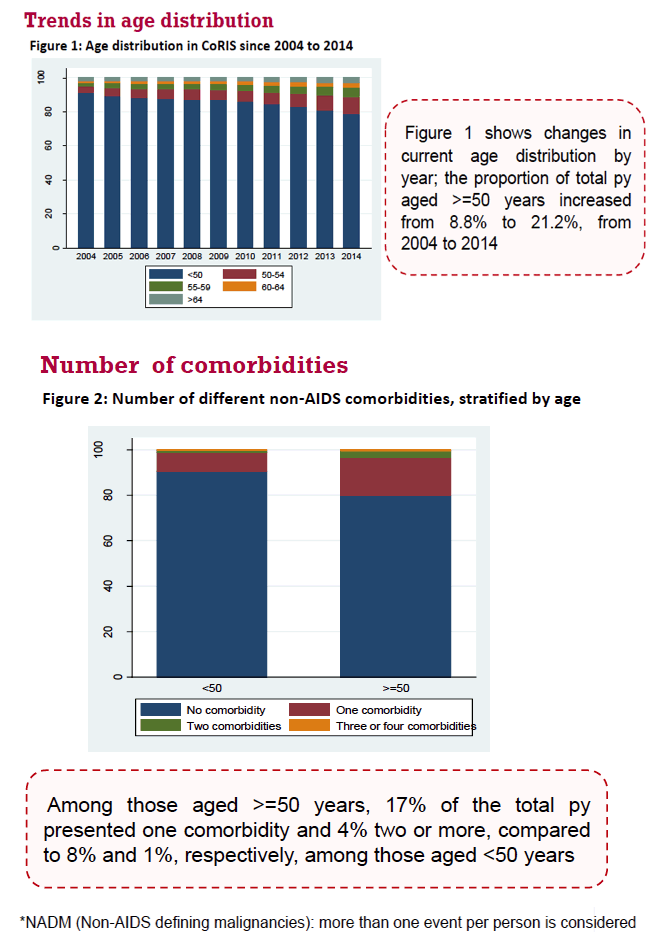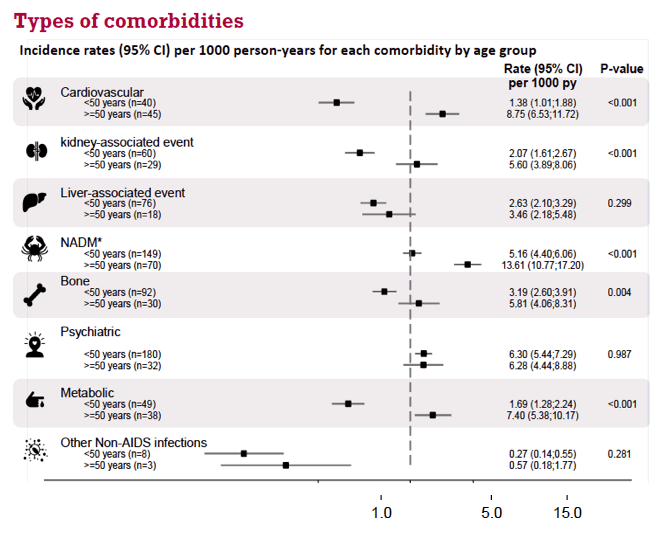 |
 |
 |
| |
Impact of Aging on non-AIDS Comorbidity in Large Spanish HIV Cohort
|
| |
| |
21st International AIDS Conference (AIDS 2016), July 18-22, 2016, Durban, South Africa
Mark Mascolini
Among Spanish CoRIS Cohort members 50 or older, almost 14 in 1000 have a new non-AIDS cancer diagnosis every year, a rate nearly 3 times higher than in younger CoRIS members [1]. Almost 9 in 1000 of the 50-or-older group have a cardiovascular disease diagnosis every year, an incidence more than 6 times higher than the younger group.
Non-AIDS diseases account for growing rates of morbidity and mortality in people surviving longer thanks to antiretroviral therapy (ART). Researchers working with the Cohort of the Spanish AIDS Research Network (CoRIS) aimed to describe patterns of non-AIDS morbidity according to age in this ongoing cohort study. Beginning in 2004, CoRIS includes HIV-positive people older than 13 at participating centers who have not begun ART when they enroll.
Focusing on people who entered the cohort from 2004 to 2014, the CoRIS team calculated incidence per 1000 person-years for several non-AIDS comorbidities and the distribution of comorbidities in cohort members younger than 50 and 50 or older. They modeled age as a time-dependent variable. The eight comorbidities analyzed were cardiovascular disease, kidney-associated events, liver-associated events, non-AIDS malignancies, bone disease, psychiatric illness, metabolic disease, and other non-AIDS infections.
The analysis involved 9569 people with HIV through 34,105 person-years of follow-up. Median age stood at 35 years (interquartile range [IQR] 29 to 43), 84% of participants were men, and 58% men who have sex with men. Median CD4 count at cohort entry stood at 350. The proportion of cohort members 50 or older grew from 8.8% in 2004 to 21.2% in 2014. In the 50-or-older group, 1 comorbidity developed during 17% of total person-years and 2 developed in 4% of person-years. Respective proportions in the younger group were 8% and 1%.
For all comorbidities except psychiatric illness, liver disease, and other non-AIDS infections, incidence was significantly greater in CoRIS members 50 or older than in younger cohort members:
-- Non-AIDS malignancy: older vs younger, 13.61 vs 5.16 per 1000 person-years, P < 0.001
-- Cardiovascular: 8.75 vs 1.38 per 1000 person-years, P < 0.001
-- Metabolic: 7.40 vs 1.69 per 1000 person-years, P < 0.001
-- Psychiatric: 6.28 versus 6.30 per 1000 person-years, P = 0.987
-- Bone: 5.81 versus 3.19 per 1000 person-years, P = 0.004
-- Kidney: 5.60 vs 2.07 per 1000 person-years, P < 0.001
-- Liver: 3.46 vs 2.63 per 1000 person-years, P = 0.299
-- Other non-AIDS infection: 0.57 versus 0.27 per 1000 person-years, P = 0.281
The CoRIS investigators concluded that "non-AIDS events have emerged as an important cause of comorbidity and multi-morbidity, especially among those with older age, and pose a new challenge for HIV treatment and care."
Reference
1. Alejos B, Hernando V, del Amo J, et al. Ageing and associated morbidity in HIV-positive persons in the Cohort of the Spanish AIDS Research Network (CoRIS). 21st International AIDS Conference (AIDS 2016). July 18-22, 2016. Durban, South Africa. Abstract WEPDB0105.
from Jules: in communication with authors 7% in 2004 and 20% in 2014 were between ages of of 50->64, so that is a tripling of numbers of patients >50, and almost a tripling of those 60-64, soon there will be a much more significant number of patients over 60 years old and then the numbers of comorbidities, multiple comorbidities, polypharmacy, falls, fractures and frailty etc problems will magnify quite a bit more, because it is after 60-65 in the general population that aging problems kick in because that is when aging related immunity decline occurs and in HIV+ this time period will result in a worse slope of decline in immunity that will occur at earlier ages than in the general population, because of the damaged immunity caused by HIV & contributed to by lower nadir CD4, and of course the association with HIV causing senescence, accelerated aging, which all contribute to a serious aging problem in HIV; numerous studies report aging accelerated by 5-15 years vs HIV-negatives. The older HIV+ population is the one most likely to have had a lower nadir CD4, more likely to have had senescence; senescence is when immunity declines [reflected by certain T-cell changes], normally in healthy people around 60-65 years old, but numerous studies found senescence occurs for HIV+ earlier than HIV-negatives and is likely to be associated with accelerated aging & increased risk for earlier comorbidities onset & increased risk for greater numbers of comorbidities, particularly frailty. These will result in decline in functional capacity for daily living activities for older HIV+ at earlier ages:
Veterans Aging Cohort Study (VACS) Index, Functional Status, and Other Patient Reported Outcomes in Older HIV-positive (HIV+) Adults in SF.....Poor Outcomes in HIV+ Aging age 53-61




|
| |
|
 |
 |
|
|